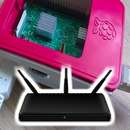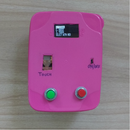Introduction: LED Panel With a Dimmer
Hi guys in this miniProject we are going to create a small LED panel with warm and cold white LEDs along with a dimmer to control their brightness.
Well, why did I create it? My room was lacking a bit of bright light.
Let's get started.
Step 1: Video
Here is a 5 min video summarizing all steps.
Step 2: Required Items
Attached image has list of required items, cost and time you will invest if you decide to recreate this miniProject.
I forgot to add hot blade and file in tools.
Step 3: Mechanical Assembly for LED Panel
I took 2 metallic plate of about 14 cm by 6 cm and connected them using 3 hole metal stripes and 4 M3 nut, bolt and washers. Then I connected 2 metal stripes of about 17 cm by 1 cm on sides again using M3 nut, bolt and washers.
Step 4: Putting LED Stripes on Panel
Once mechanical assembly was ready, It was time for warm and cold LED stripe roles. I took some measurements on LED panel to see how many LED segments would fit and then started chopping off LED stripes into pieces.
Once done I stuck all LED segments onto the panel. I stuck warm and cold LED stripes in alternating fashion. Try to keep polarity of LED stripes consistent, this will make process of creating electrical connections easy.
Step 5: Create Electrical Connections for LED Stripes
For electrical connectivity I shorted ground terminals of all warm and cold white LED segments separately creating 2 ground terminals. I did same for 12 V terminals. I made this connections using some double sided tape, non insulated wire and solder.
Once done, I took out a multimeter and measured current consumed by LED panel. It came to be around 670 mA and with that our LED panel was ready, next step is to create dimmer circuit.
Step 6: 555 Timer Based Dimmer Circuit
I decided to use 555 timer to generate PWM signal for LED panel. Circuit is fairly straight forward, 2 1N4148 diodes along with a 10K pot controls direction and amount of charging and discharging current for a 100 nF capacitor. This capacitor's voltage when shorted to threshold and trigger pin of 555 timer generates a PWM signal at pin 3 depending on resistance division of potentiometer.
This PWM signal will go to a MOSFET board which will do heavy job of switching 670 mA. As our PWM frequency is not going to be above 20 KHz, we can get away with a resistive gate driven D4184 MOSFET modules available in market.
We need to create two identical circuits, one each for warm and cold LED segments.
Before soldering circuit on perf board, I tried it on a breadboard. Once it produced desired results, I took required components and started assembling them on a perf board.
Step 7: Assembling Components on Perf Board
Potentiometers had to go through a bit of modification, where I soldered male jumper wires to their terminals and secured them using heat shrink tubes.
Before connecting MOSFET modules on perf board, I connected multimeter to output pin of 555 timer to measure frequency and duty cycle of PWM signal. Frequency of PWM signal varied between 1.8K to 1.4K Hz while duty cycle varied between 0.1% to 99.6%.
Later I attached MOSFET modules on perf board.
Step 8: Modifying Plastic Enclosure
Once perf board was ready I started modifying plastic enclosure. I made 3 holes for female DC jacks, where one provided power supply and other two provided PWM signal to warm and cold white LED segments. I made another two holes for potentiometers. I did this with the help of a hot blade and file.
Step 9: Getting Stuff Together
Later, I placed perf board inside enclosure and soldered remaining connections. On LED panel side, I attached 2 female DC jacks on a panel stripe using strong glue and soldered remaining connections there too.
For connecting LED panel with dimmer circuit I took four 1.5 meter wire and attached them to four male DC jacks two on each side.
Step 10: Testing
Finally it's time for a run. I attached LED panel to dimmer and connected a 12V 2A power supply. As soon as I did that LED panel lit up and potentiometers were able to control brightness of LED panel.
That's it folks. Thank you for reading.
Don't forget to checkout my other projects.




